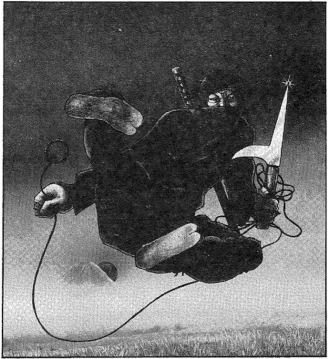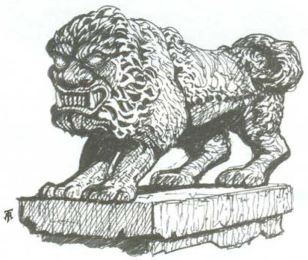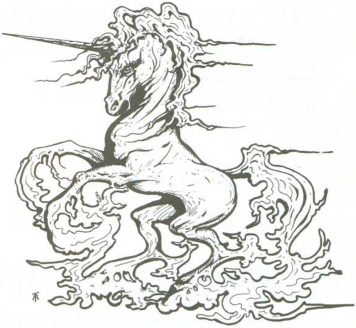This post continues the discussion started here.
I observed in my last post that in the mid 1980s a far eastern setting was almost obligatory for a fantasy game. Warhammer had such a setting from its early days. WFB1 introduced the “men of the Orient” in Forces of Fantasy and ‘The Tale of Sanyo Kawasaki’ in The Book of Battalions. By the time WFRP1 was launched, the background had expanded from this and included the lands of Cathay and Nippon.
Nippon is described in five sources contemporary with GW’s first edition of WFRP: WFB2, Ravening Hordes, WFRP1, WFB3 and Warhammer Armies.

WFB2
In WFB2 Nippon is presented as part of Cathay:
Cathay is a huge land corresponding to the far east of our own world. The mid-coastal areas are temperate and fertile, whilst to the west and north lie great deserts, and to the south impenetrable jungles. The Old Worlders have only just established trading contacts with this land – and are not always welcome.
Cathay is dominated by humans, although remoter areas are still under the control of goblinoids, especially Hobgoblins. There are many states and cultures within this area, of varying sophistication and technology. The largest state is Imperial Cathay, where gunpowder technology is known, but not fully exploited. Society within the east is insular and unenterprising, a situation enhanced by the universal Simca religion. The large island off the coast of Cathay is called Nippon; an independent state of tough, sea-going peasantry and stern feudal overlords called Shogun.
– Warhammer Fantasy Battle, second edition, ‘Battle Bestiary’, p9
Cathay … comprises of [sic] a large number of independant [sic] monarch states, somewhat like the far east of our own world in ancient times. All of these states have introverted and complex governmental bodies, unfathomable legal systems and rigidly stratified social heirarchies [sic].
There are many different languages spoken in Cathay, [sic] their common tongue of more civilised areas is called Cathan.
Technology and society varies tremendously from the stone-age head-hunting barbarians of the south to the ordered civilisations of the North, including Nippon and Imperial Cathay. Much of Cathay is sub-tropical or mountainous, the domain of countless primitive tribes as well as other humanoid creatures. Although gunpowder technology is known in Cathay, lack of imagination and innate conservatism prevent its widespread use.
Apart from the primative [sic] tribes and a few independantly [sic] minded states, the Orientals worship a common god called The Orange Simca. Simca corresponds closely with the worship of Buddah [sic] in our world. Monks wear orange robes and spend most of their time in contemplation. Vimto is the martial version of Simcism.
In Nippon the Samurai have developed their skills to a level far above those of normal humans. Fatalism has reached such a peak in these warriors that some can become kamikaze (subject to frenzy). A kamikaze not killed in battle will kill himself, believing that his time has come and that to live on would affront Simca. Even these warriors are outclassed by the Vimto monks. They do not need weapons but fight with their bare hands.
– Warhammer Fantasy Battle, second edition, ‘Battle Bestiary’, pp21-22
RAVENING HORDES

Ravening Hordes included an army list for Nippon, which featured the familiar tropes of samurai, warrior monks, ashigaru and ninja.
The Samurai classes dominate Nippon society. Their land is so vast and so often inhospitable, the Samurai so strong and the Emperor so weak, that central control has all but disappeared. Society is normally run by the Samurai, who exchange their protection for control over the towns and cities, along with taxes and the right to levy militias. As the Samurai have grown in strength, so has each settlement’s need for the Samurai. The Samurai’s training, devotion and continual practice have turned them into awesome fighters.
Nippon abounds with diverse orders of monks, either martial or clerical. The Orders select their members at a very early age and the chosen ones devote their entire lives to philosophy, theology and the martial arts. A lifetime of gruelling study hones their bodies and minds to a very fine edge.
Ninja assassins are dark agents of death who prey upon the unwary and slay them without mercy.
Many young, fanatical warriors are so devoted to their cause that they regard it as a high honour to die in battle. These warriors are prepared to go into battle as human bombs, carrying either a cask of black powder or bandoliers loaded with separate explosive charges.
Nippon peasants are reluctant to fight for their Samurai overlords, however sometimes they have no choice!
– Ravening Hordes, pp41-42
Notably Nippon contingents were permitted to include ogre mercenaries and giant allies.
Ravening Hordes also introduced a selection of new oriental weapons: kusarigama (sickle flail), shuriken (throwing star), torinoko grenades (gunpowder missiles), arquebus, firelock pistols (“grudgingly adopted by the Samurai”), rockets and cannon.
WFRP1
The description of the Far East in WFRP1 is derived from that in WFB2:
The largest states in this vast area are Imperial Cathay and the islands of Nippon, but there are numerous separate states within this area of varying sophistication and technology. There is a wide climactic [sic] variation over the region, from the temperate and fertile mid-coastal plains, to the great western and northern deserts, to the impenetrable jungles of the south. Although largely dominated by Humans, more remote areas of the Far East are still under Goblinoid control – especially Hobgoblins.
The cultural outlook and society of the many states in this area contrasts sharply with that of the Old World, and although trading contacts have recently been established, outsiders are not always welcome.
– Warhammer Fantasy Roleplay, first edition, p261
WFB3
WFB3 has very little to say directly about Nippon, but it does hint at a Nippon supplement, which was surely Tetsubo.
A complete guide to the lands of Nippon is already under development.
– Warhammer Fantasy Battle, third edition, p194
WARHAMMER ARMIES

Warhammer Armies contained bestiary entries for temple dogs and ki-rin and a short army list for a Nipponese mercenary contingent containing samurai, ninja and ashigaru. The accompanying text mainly focuses on providing reasons for their presence in other armies:
The inscrutable Eastern Empire known as Nippon is ruled by a reclusive semi-divine Emperor, but real power lies in the hands of the many feudal warlords or ‘Samurai’. These warrior nobles govern large domains with which they frequently indulge in private wars among themselves. Nippon is an island realm and a notable sea power and it sometimes happens that a Samurai war fleet is dispersed by a typhoon, scattering the ships far and wide. Should an isolated war junk fetch up on a foreign shore the Samurai commander will gather his men and march straight for the nearest representative of authority to offer his services in return for food and shelter. Sometimes Samurai lords deliberately embark their followers into war junks and set sail towards the rising sun in search of adventure, especially if the other feudal clans back home in Nippon are cramping his style.
– Warhammer Armies, p156
OVERALL
The Nippon described in the various Warhammer publications above is quite unoriginal. It contains familiar motifs of samurai, ninja, and suchlike, but nothing new or distinctive. It scarcely differs from the generic pseudo-Japanese settings of other RPGs, except that it is more sparsely described.
The next post will look at Tetsubo.
Title art by Toyohara Chikanobu. Internal art by Russ Nicholson, Tony Ackland, et al. Used without permission. No challenge intended to rights holders.

Perhaps the one significant change from a standard pillaging of Japan’s past are the references to war fleets and Nippon as an expansive and adventurous sea power. Whilst I know that it wasn’t entirely unknown (there was a major invasion of Korea in the sixteenth century, wasn’t there?) the general history of Japan has been a surprisingly insular one, especially in the popular imagination. One can’t help but feel that these references were there to provide an excuse to shoehorn your Nipponese painted minis into conflicts that might otherwise appear unlikely.
It is interesting to think that, had this been written a more recently, the interest in the Chinese Imperial Treasure fleets of the last few years of the fifteenth century and the increased importance of China as a current global power would probably have meant it was Cathay that was said to spread its war junks far and wide.
LikeLiked by 1 person